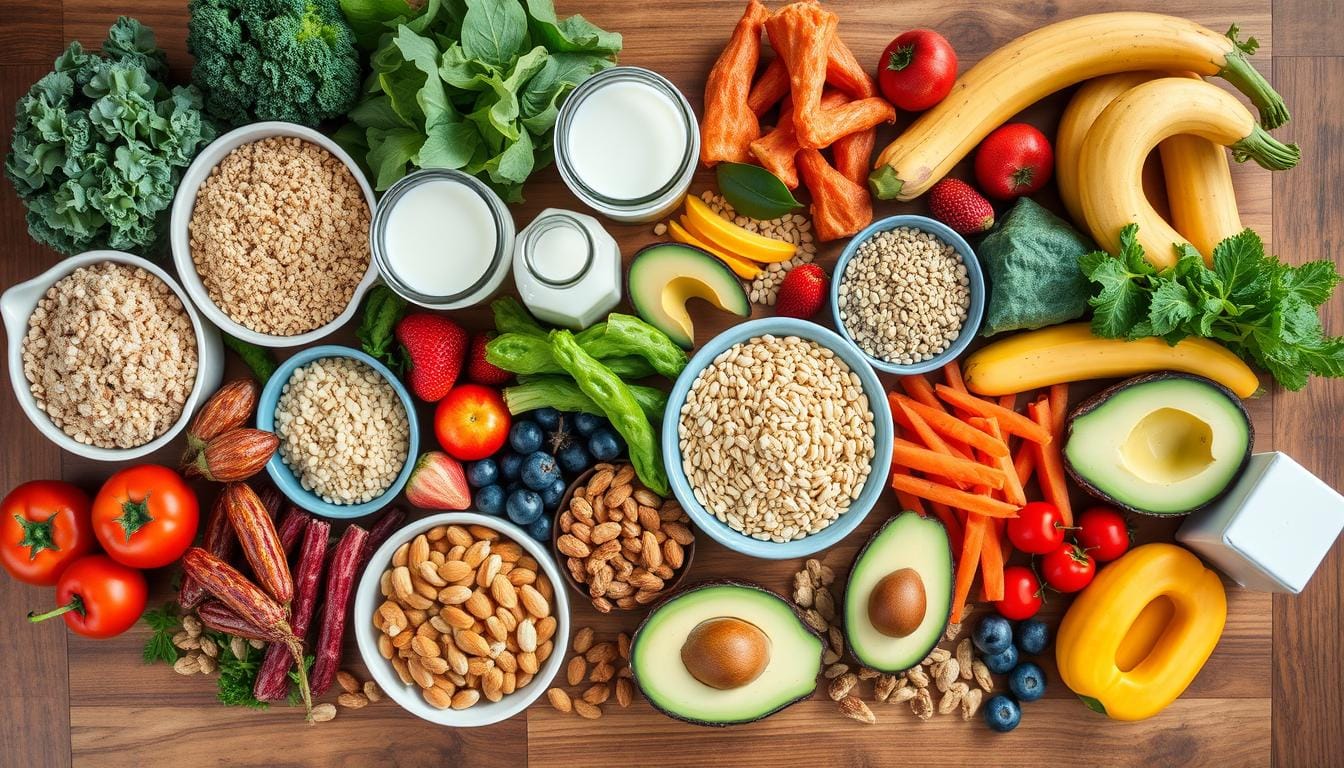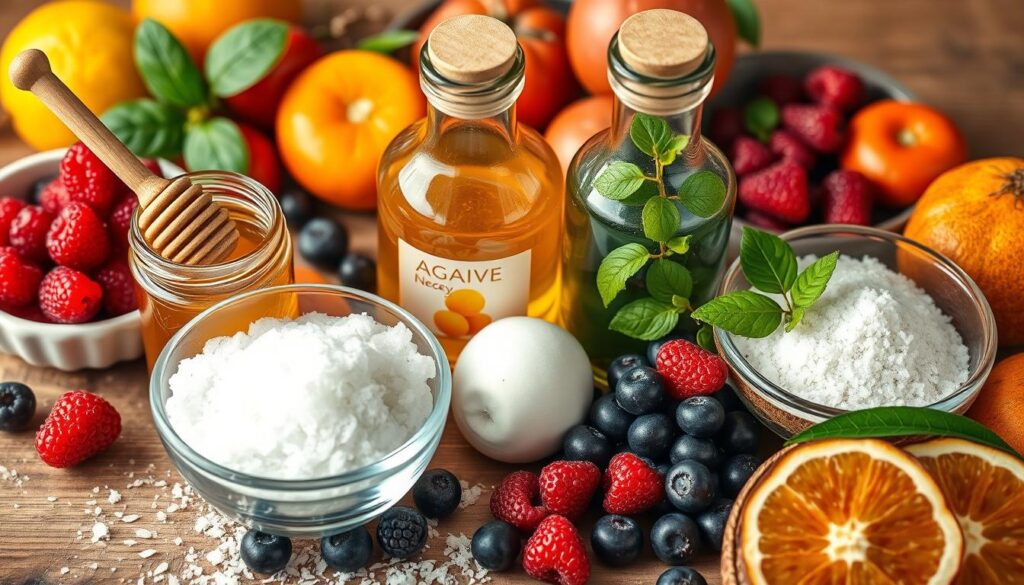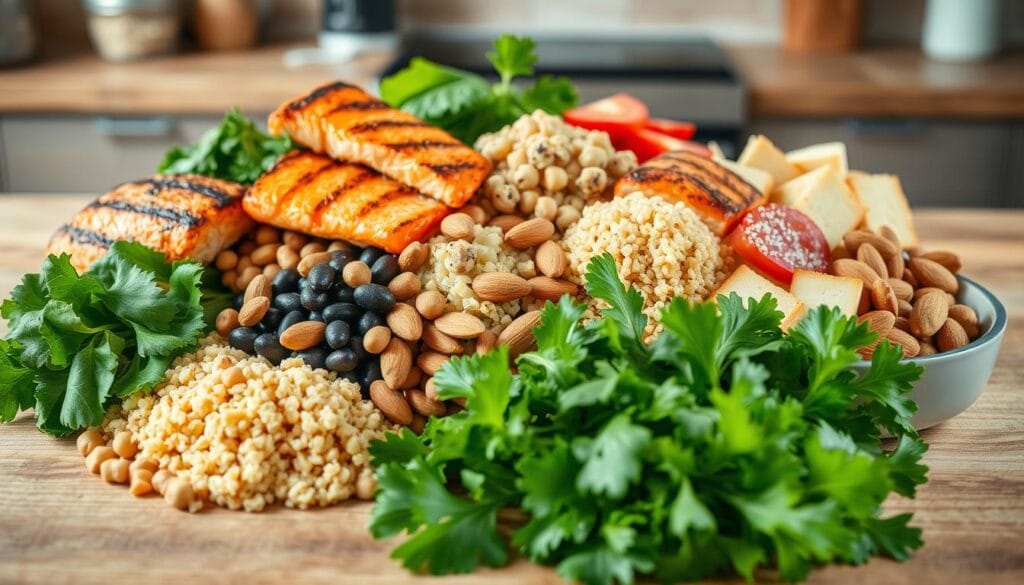Reflecting on my journey to a healthier lifestyle, I’m amazed by the power of small changes. Swapping sugary drinks for water, choosing whole grains over refined ones, and reducing sodium and unhealthy fats can make a big difference. These simple swaps can greatly improve our well-being. In this article, we’ll dive into healthy substitutions that boost vitality and contentment. By making these smart swaps, you’ll nourish your body and enjoy delicious, wholesome food.
Let’s start this journey together and see how healthy substitutions can make us happier and healthier.
Understanding Healthy Substitutions
Healthy substitutions mean swapping out less healthy ingredients for clean food replacements and wholesome ingredient options. These changes can greatly improve your diet and health. By choosing wisely, you can eat fewer calories, get more nutrients, and help manage your weight and health risks.
What Are Healthy Substitutions?
Healthy substitutions are when you pick ingredients that are better for you than usual ones. For instance, picking whole wheat bread over white bread, or Greek yogurt instead of sour cream. These swaps can really make a difference in your diet.
Benefits of Making Smart Swaps
- Better weight management
- Improved heart health
- Reduced risk of chronic diseases like diabetes and certain cancers
- Increased nutrient intake
- Satisfying textures and flavors
By adding clean food replacements and wholesome ingredient options to your meals, you can enjoy tasty food while being healthier. It’s about making small, lasting changes for better health over time.
“Healthy substitutions are a simple yet powerful way to upgrade your diet and improve your overall well-being.”
Whole Grains vs. Refined Grains: healthy substitutions
Choosing whole grains over refined ones is a big step towards better health. Whole grains have more fiber, vitamins, and minerals. They offer a better-for-you ingredient choice that can improve your health.
Exploring Whole Grain Options
Adding whole grains to your diet is simple. Some tasty and nutritious ingredient substitutes are:
- Brown rice
- Quinoa
- Oats
- Whole wheat pasta
These whole grains are a healthier choice than refined grains like white bread and pasta.
How to Incorporate Whole Grains
Switching to whole grains is easy. Just swap out your usual refined grain products. Use whole wheat bread instead of white, brown rice instead of white, and whole grain cereals instead of sugary ones. These changes can greatly improve your health by reducing sugar intake and increasing fiber.
“Whole grains are emphasized in the American Heart Association’s dietary recommendations as they can reduce the risk of heart disease, stroke, and diabetes.”
It’s important to try different whole grains. Explore options like barley, farro, and millet. This way, you can enjoy a wide variety of nutritious ingredients.
Healthier Fats for Your Diet
Choosing the right fats is key to a healthy lifestyle. Saturated fats can harm your heart, but unsaturated fats offer many benefits. By swapping cooking oils and fats, you can enjoy tasty, healthy meals.
Unsaturated vs. Saturated Fats
Unsaturated fats, like olive oil, avocado, and nuts, are better for you. They help lower cholesterol and reduce heart disease risk. On the other hand, saturated fats in butter, red meat, and fried foods can harm your heart.
Smart Swaps for Cooking Oils
- Choose healthier cooking oils like olive oil, canola oil, or avocado oil instead of butter or lard.
- Use olive oil or mashed avocado instead of butter when baking for a healthier treat.
- For sautéing and stir-frying, pick nontropical vegetable oils like corn or safflower oil over butter or coconut oil.
- Try grilling, roasting, or steaming instead of deep-frying to cut down on unhealthy fats.
These simple swaps can greatly reduce saturated fats in your diet. Adopting these healthy cooking hacks and guilt-free ingredient swaps can significantly boost your health and well-being.
“Cooking with healthier fats is a small change that can have a big impact on your heart health.”
Sugar Alternatives That Taste Great
Reducing sugar intake is key to a healthier life. Luckily, many sugar alternatives taste great and offer health benefits. Let’s look at natural sweeteners and smart swaps to curb sweet cravings without losing flavor.
Natural Sweeteners to Try
- Stevia is a zero-calorie sweetener, 450 times sweeter than sugar. It’s perfect for drinks, baking, and as a sweetener.
- Erythritol has just 0.2 calories per gram. It’s a low-calorie option for cooking and baking.
- Monk fruit extract is 300 times sweeter than sugar and calorie-free. It’s a healthy choice for desserts and drinks.
- Dates are healthy and don’t raise blood sugar like table sugar. They’re great for baked goods and smoothies.
- Honey has a lower glycemic index than sugar. It’s anti-inflammatory and antioxidant-rich, making it versatile for recipes.
Reducing Sugar in Recipes
Using natural sweeteners is just the start. You can also reduce sugar in recipes. Try using applesauce or mashed bananas instead of sugar in baked goods. Choose no-sugar-added cereals and snacks.
For drinks, try water with fruit or herbs instead of sugary ones. These low-calorie swaps and smart food substitutions help cut down sugar intake.
“The average American consumes about 68 grams of sugar per day, which can lead to adding up to 28 pounds of body fat per year.”
By using natural sweeteners and making smart low-calorie swaps and smart food substitutions, you can enjoy sweet flavors. This supports your health and well-being.
Dairy Substitutions for a Healthier You
Choosing nutritious alternatives to dairy can greatly improve your health. If you’re lactose intolerant, worried about the environment, or want to eat less saturated fat, there are many healthy substitutions out there.
Alternatives to Milk and Cream
Switch to low-fat or skim milk to lower saturated fat. For a better choice, try plant-based milks like almond, soy, or oat milk. They’re full of vitamins and minerals, but have fewer calories and fat.
For cream, use evaporated fat-free milk or mix yogurt and cottage cheese. This gives you a creamy texture without extra calories.
Plant-Based Yogurt and Cheese Options
- Try plant-based yogurts made from soy, coconut, or almond milk. They’re creamy and free from animal products.
- For cheese lovers, go for reduced-fat cheese or nutritional yeast. It tastes cheesy without the dairy.
By choosing these healthy substitutions and nutritious alternatives, you can eat better and cut down on saturated fats and animal products. Finding the right dairy substitutes that you like and fit your diet is important for lasting changes.
Protein Sources: Choose Wisely
Choosing the right protein is key to your health. Lean meats and plant-based proteins are great. They give you the nutrients you need and keep you healthy.
Lean Meats vs. Processed Meats
Lean meats like chicken, turkey, and some fish are top protein picks. They’re low in bad fats and good for your heart. But, avoid processed meats like deli meats and sausages. They’re high in salt and unhealthy fats.
Plant-Based Protein Swaps
Adding beans, lentils, and tofu to your meals is smart. They’re full of fiber and nutrients. Plus, they’re low in bad fats, making them a better choice than meat.
| Protein Source | Protein per Serving |
|---|---|
| Salmon (3 oz fillet) | 39.3 g |
| Chicken Breast (3 oz) | 22.5 g |
| Bison (3 oz) | 21.6 g |
| Turkey Breast (3 oz) | 25.6 g |
| Halibut (3 oz) | 29.3 g |
| Eggs (1 large) | 6.3 g |
| Greek Yogurt (7 oz) | 19.9 g |
| Cottage Cheese (4 oz) | 12.5 g |
| Black Beans (1 cup) | 15.2 g |
| Lima Beans (1 cup) | 11.9 g |
By choosing wisely, you can eat well and stay healthy. Clean food replacements are the way to go for a balanced diet.
Flavor Enhancers Without the Guilt
Finding ways to add flavor to healthy dishes can be tough. It’s hard to avoid unhealthy ingredients like too much salt, sugar, or fat. But, with some healthy cooking hacks and guilt-free ingredient swaps, you can make your food taste great while staying healthy.
Herbs and Spices Instead of Salt
Lowering your sodium intake is key for a healthier diet. It’s simpler than you think. Try using herbs and spices instead of salt to add flavor to your meals. Garlic, basil, oregano, and lemon juice are great alternatives that don’t lose the taste.
Low-Calorie Dressings and Sauces
Many store-bought dressings and sauces are full of unhealthy fats and sugars. Make your own with healthier ingredients like Greek yogurt, vinegar, and fresh herbs. These options are not only tasty but also help you save calories without losing flavor in your salads, veggies, or other dishes.
| Ingredient | Healthy Substitution | Benefits |
|---|---|---|
| Heavy Creams | Coconut Milk, Almond Milk | Lighter texture, fewer calories |
| Processed Sugar | Natural Sweeteners (Honey, Maple Syrup, Agave) | Balanced sweetness, wholesome nutrients |
| Chocolate Syrup | Stevia or Monk Fruit Based Alternatives | Rich flavor, zero calories |
Using these healthy cooking hacks and guilt-free ingredient swaps can make your food taste amazing without harming your health. Try new herbs, spices, and homemade dressings. You’ll find a world of delicious, healthy dishes that are good for your taste buds and body.
Snacks: Healthier Choices for Cravings
Dealing with snack cravings can be tough. But, making low-calorie swaps and picking smart food substitutions can keep you on track. Choose nutritious snacks that taste great but don’t ruin your health goals.
Nutritious Snack Ideas
- Fresh fruit like berries, apples, or bananas
- Vegetable sticks with hummus or guacamole
- A small handful of unsalted nuts or seeds
- Greek yogurt with a drizzle of honey and fresh fruit
- Edamame, a low-calorie snack high in fiber and protein
- Miso soup, which has been linked to reduced disease risk
Homemade Alternatives to Processed Snacks
It’s easy to grab pre-packaged snacks. But, making your own snacks at home is healthier and cheaper. Swap out high-calorie, sugary treats for these tasty homemade options:
- Homemade popcorn seasoned with herbs and spices instead of store-bought varieties
- Frozen fruit popsicles or smoothies instead of ice cream
- Trail mix with nuts, seeds, and dried fruit instead of candy or chips
- Roasted chickpeas or kale chips instead of potato chips
- Chia pudding or cottage cheese dip with fresh veggies instead of high-fat dips
By choosing low-calorie swaps and smart food substitutions, you can enjoy snacks while keeping your body healthy. Try different healthy snacks to find what you love. This way, you can make lasting changes for your well-being.
Practical Tips for Making Substitutions
Making your meals healthier doesn’t have to be hard. Start by changing one or two ingredients at a time. This lets your taste buds get used to better-for-you ingredient choices. This way, you can make lasting changes to your health.
Gradual Changes for Lasting Impact
Once you get the hang of a few swaps, keep trying new ones. Try out new recipes with these healthier ingredients. This keeps your meals fun and tasty.
Use tools like the NHS Food Scanner app to find healthier options. Look for products with the “Good Choice” badge or more green labels.
Keeping It Exciting with New Recipes
Small changes can make a big difference in your health. By slowly adding these swaps, you’re on your way to a healthier life. Explore new ingredients and recipes – there are endless ways to make delicious, healthy choices.
FAQ
What are healthy substitutions?
Healthy substitutions are small changes in your diet that can greatly improve your health. They involve swapping less healthy ingredients for better ones. This helps cut down on sodium, added sugars, fats, and cholesterol.
What are the benefits of making healthy substitutions?
Making healthy substitutions can lead to better weight management and heart health. It also lowers the risk of chronic diseases. These changes help you eat well while still enjoying tasty meals.
How can I incorporate more whole grains into my diet?
Try using whole wheat instead of white bread, brown rice instead of white, and whole grain cereals. Whole grains are packed with fiber, vitamins, and minerals. They help reduce sugar intake and boost fiber.
What are some healthier alternatives to saturated fats?
Use olive oil or avocado instead of butter in baking. Choose nontropical vegetable oils like canola or olive oil over butter or lard. Grilling, roasting, or steaming are better than frying to cut down on saturated fats.
How can I reduce my sugar intake?
Use natural sweeteners like stevia or monk fruit. In baking, try applesauce or mashed bananas instead of sugar. Choose no-sugar-added cereals and snacks. Drink water with fruit or herbs instead of sugary drinks.
What are some dairy substitutions I can make?
Switch to low-fat or skim milk to lower saturated fat. Use plant-based milks like almond or soy in recipes. Replace cream with evaporated fat-free milk or yogurt and cottage cheese mix. Opt for reduced-fat cheese or nutritional yeast for flavor.
How can I make healthier protein choices?
Choose lean meats like chicken or fish over processed meats. Add plant-based proteins like beans or tofu to your diet. Use lean ground turkey or plant-based alternatives to reduce fat and increase fiber.
What are some ways to add flavor without using a lot of salt?
Use herbs and spices like garlic or oregano for flavor. Try lemon juice or homemade dressings with Greek yogurt and herbs. Avoid high-calorie store-bought sauces.
What are some healthier snack options?
Opt for fresh fruit, veggie sticks with hummus, or unsalted nuts. Make homemade popcorn with herbs instead of pre-packaged snacks. Swap ice cream for frozen yogurt or fruit popsicles.
How can I make healthy substitutions sustainable?
Start with small changes and build up. Try new recipes with healthier ingredients. Use the NHS Food Scanner app to find better options when shopping.



